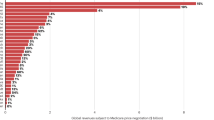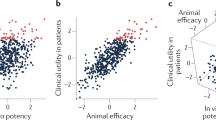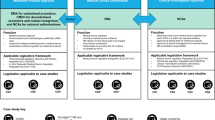Key Points
-
The prices of pharmaceutical products are being constantly criticized in the United States, and they are also subject to increasing challenge throughout the rest of the world.
-
However, certain fundamental aspects of drug development and the markets in which drugs are sold are crucial determinants of the prices that are charged by the industry. For example, drug development is risky, with high costs that must be incurred years before any returns can be realized.
-
The process of determining the price for a new pharmaceutical product starts early in development, several years before launch. The pharmaceutical company must estimate the value of the product to its customers as well as the willingness and ability of different consumers to pay for it. The company must also determine a price threshold above which the return on investment in research and development will be sufficient to satisfy its investors.
-
Here, we describe the methodological framework that is used by many manufacturers to set the price of new drugs, highlighting the challenges that are encountered and the complex trade-offs that must be managed, as well as outlining how emerging trends could influence the practice of pricing and value justification in the future.
Abstract
The pricing of medicines has become one of the most hotly debated topics of recent times, with the pharmaceutical industry seemingly being attacked from all quarters. From a company perspective, determining the price for each new product is more crucial than ever, given the present dearth of new drug introductions. But how are pricing strategies developed in practice? What is value-based pricing and how are financial models of return on investment constructed? What are the challenges faced in setting the price for a particular product, and how will scientific and environmental trends provide future pricing challenges or opportunities?
This is a preview of subscription content, access via your institution
Access options
Subscribe to this journal
Receive 12 print issues and online access
$209.00 per year
only $17.42 per issue
Buy this article
- Purchase on Springer Link
- Instant access to full article PDF
Prices may be subject to local taxes which are calculated during checkout




Similar content being viewed by others
References
Congressional Record, H2701–H2702, 6 May 2004.
MEDTAP International. The Value of Investment in Health Care: Better Care, Better Lives. Executive Summary (MEDTAP, Bethesda, Maryland, 2003) [online] <http://www.medtap.com/Products/HP_ExecutiveSummary.pdf> (2004).
WHO Collaborating Centre for Drug Statistics Methodology [online] <http://www.whocc.no/atcddd> (2004).
Gold, M. R., Siegel, J. E., Russell, L. B. & Weinstein, M. C. (eds) Cost-effectiveness in Health and Medicine (Oxford Univ. Press, New York, 1996).
Drummond, M. F., O'Brien, B., Stoddart, G. & Torrance, G. W. Methods for the Economic Evaluation of Health Care Programmes 2nd edn (Oxford Univ. Press, Oxford, 1997).
Garrison, L. et al. The drug budget silo mentality in Europe. Value in Health 6, s1 (2003).
Pharmaceutical Research and Manufacturers of America. New Drug Approvals in 2001 (PhRMA, Washington DC, 2002).
Kanavos, P., Costa-i-Font, J., Merkur, S. & Gemmill, M. The Economic Impact of Pharmaceutical Parallel Trade in European Union Member States: A Stakeholder Analysis. LSE Health and Social Care Special Research Paper (London School of Economics and Political Science, 2004).
West, P. & Mahon, J. Benefits to Payers and Patients from Parallel Trade (York Health Economics Consortium, Univ. of York, 2003).
Paul, J. E. & Trueman, P. 'Fourth hurdle reviews', NICE, and database applications. Pharmacoepidemiol. Drug Saf. 10, 429–438 (2001).
Nagle, T. T. & Holden, R. K. The Strategy and Tactics of Pricing (Prentice Hall, New Jersey, 2002).
Author information
Authors and Affiliations
Corresponding author
Ethics declarations
Competing interests
N.G. and K.S. are owners of PriceSpective, a pricing and reimbursement consultancy providing services to the pharmaceutical industry, and both hold stock options in a major pharmaceutical company. J.M. and J.P. are employed by RTI Health Solutions, a consultancy providing services to the pharmaceutical industry.
Related links
Related links
DATABASES
Entrez Gene
OMIM
Glossary
- NEW MOLECULAR ENTITY
-
A medication containing an active ingredient that has not been previously approved for marketing in any form.
- 'ANATOMICAL THERAPEUTIC CHEMICAL' (ATC) CLASSIFICATION SYSTEM
-
This was set up by the World Health Organization (WHO) as a tool for research into drug use, and divides drugs into different groups according to the organ or system on which they act, and their chemical, pharmacological and therapeutic properties.
- NET PRESENT VALUE
-
(NPV). The difference between the discounted projected revenues and the discounted projected costs over the product lifecycle.
Rights and permissions
About this article
Cite this article
Gregson, N., Sparrowhawk, K., Mauskopf, J. et al. Pricing medicines: theory and practice, challenges and opportunities. Nat Rev Drug Discov 4, 121–130 (2005). https://doi.org/10.1038/nrd1633
Issue Date:
DOI: https://doi.org/10.1038/nrd1633
This article is cited by
-
Impact of disabled circadian clock on yellow fever mosquito Aedes aegypti fitness and behaviors
Scientific Reports (2022)
-
Relationships between developmental strategies for additional indications and price revisions for anticancer drugs in Japan
BMC Health Services Research (2021)
-
Factors influencing pharmaceutical pricing - a scoping review of academic literature in health science
Journal of Pharmaceutical Policy and Practice (2019)
-
Pharmaceutical Price Schemes in Europe: Time for a ‘Continental’ One?
PharmacoEconomics (2016)
-
Early decision-analytic modeling – a case study on vascular closure devices
BMC Health Services Research (2015)



